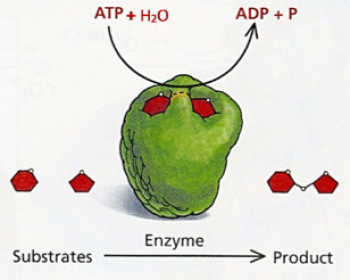Serendip is an independent site partnering with faculty at multiple colleges and universities around the world. Happy exploring!
How do organisms use energy?

This analysis and discussion activity introduces students to the basic principles of how organisms use energy.
Students learn that, in cellular respiration, glucose is one input for reactions that provide the energy to make ATP. The hydrolysis of ATP provides the energy for many cellular processes.
Students apply the principles of conservation of energy and conservation of matter to avoid common errors and correct common misconceptions.

The Student Handout is available in the first two attached files and as a Google doc designed for use in distance learning and online instruction. The Teacher Notes, available in the last two attached files, provide instructional suggestions and background information and explain how this activity is aligned with the Next Generation Science Standards.
| Attachment | Size |
|---|---|
| how organisms use energy SH.docx | 1.53 MB |
| how organisms use energy SH.pdf | 203.82 KB |
| how organisms use energy TN.docx | 3.96 MB |
| how organisms use energy TN.pdf | 461.16 KB |










Comments
2024 revision
The Student Handout has been reorganized for better logical flow, and some of the questions have been revised for clarity. The Teacher Notes have been reorganized and supplemented with improved figures.
Ingrid
i teach biology at Port
i teach biology at Port Charlotte High in Florida. I would like to use these resources, thanks Dawn Wilder.
Using These Resources
Please do use these resources in your teaching! Our use policy is described in the left-hand column.
Good luck,
Ingrid
Answer Key
Hello,
I am using a few of these activities to teach my students concepts for our anatomy and physiology course. May I have a student answer key for this exercise? I'm also interested in answer keys for cell factory and cell diversity.
Best,
Fern
Answer key
Please see the Teacher Notes for instructional suggestions, background biology, and information about how to request the key.
Thanks,
Ingrid
2016 revision
The Student Handout and Teacher Preparation Notes have been revised to improve the accuracy of the descriptions of chemical energy and energy metabolism.
2015 revision
In this revision, we have clarified the explanations and questions in the Student Handout, improved the scientific precision of the wording, and added explanations concerning challenging issues to the Teacher Notes.
2014 revision
The Student Handout has been substantially revised to align this activity more closely with the Next Generation Science Standards and to improve student understanding of energy, ATP and cellular respiration. The revised Teacher Notes provide improved teaching suggestions and background information.
cwon't let me downoad
Hello.
Is there an issue with downloading. It comes up with an error?
Help with Download Problems
I'm sorry that you are experiencing problems with downloads. We think we have identified the problem which we will fix it as soon as possible. Meanwhile, as a temporary approach to resolving this problem, I propose the following:
Ingrid Waldron
iwaldron@saas.upenn.edu
2013 revision
The 2013 revision of this activity has clarified explanations and questions in the Student Handout and background information and an optional additional activity "Sports Physiology – Energy" in the Teacher Notes.
biology
information on the website is very helpful to me and my wife in preparing to teach biology, thank you.
Biology
First question in the handout states that "opposite charges repel"...that should be "like charges repel".
Error in Student Handout Fixed
Thank you so much for letting me know about this error. I have posted a corrected student handout.
Thanks again,
Ingrid
ADP+P=ATP
Thank you so much. This is very clear and well-organized. We're just finishing up plant growth in which teams of students chose independent variables and recorded data. We're also comparing photosynthesis and respiration.
The "misconceptions" resources are well-organized.
Thanks again.
Gamal
biology
this is an awesome website..... thank you, thank you, thank you
Post new comment